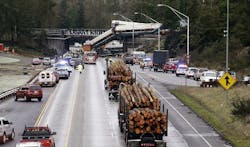For many truck drivers, Dec. 18 was already going to be a stressful day. It would be the first time they were legally required to use an electronic logging device (ELD).
If any of them were traveling on Interstate 5 between Seattle and Portland, OR, the new realities of the electronic age quickly became clear after a deadly Amtrak derailment sent a number of rail cars onto Interstate 5.
More than 48 hours later, the critical link from Canada to Mexico along the West Coast was still closed in the southbound direction. Long backups were also plaguing the detours as the crash investigation continued.
Watching the events unfold in real-time on the local news stations in my current hometown of Portland, I was struck by how many trucks were stuck in the traffic jam.
As additional video came across the television from news helicopters, scenes of one of the nation’s busiest interstates with no vehicles in sight for miles were eerie. While news anchors tended to call the highway “empty,” a closer glance showed the I-5 shoulder filled with many truckers pulled off to the side of the road.
And that brings me back to the timing with the ELD mandate. For the thousands of truckers that continue to be caught up in the traffic, it is inevitable that some customers will not receive their shipments as initially scheduled.
Prior to Dec. 18, a trucker may have bent his or her hours of service (HOS) in order to compensate for the delay, especially coming just one week prior to Christmas day.
However, if drivers are using an ELD as legally required, that is no longer supposed to be an option. That means more juggling among truckers, fleet managers, and shippers alike.
Maybe the delays caused by this train crash will one day be used as part of the evidence that additional HOS flexibility must be implemented to accommodate the realities of the ELD era.
If nothing else, this horrible accident shows just how many factors impact the lives of today’s truck drivers beyond just one single controversial mandate.
About the Author
Neil Abt
Neil Abt is a former FleetOwner editor who wrote for the publication from 2017 to 2020. He was editorial director from 2018 to 2020.
